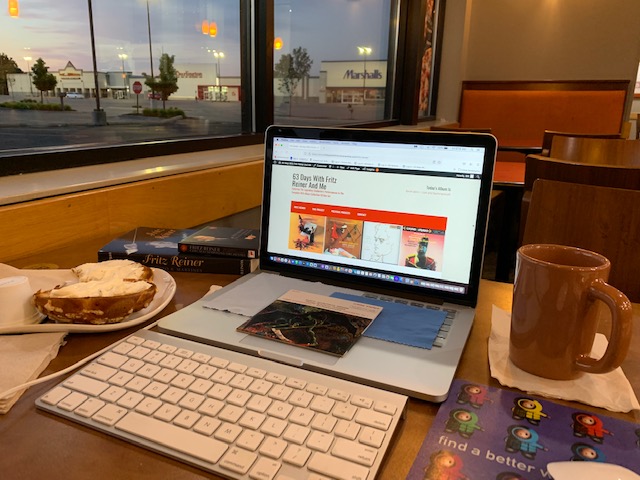
This is just the kind of music I needed this morning to broom the cobwebs out of my mind.
Well, a better verb would be jackhammering.
Because some of this is really, really loud and busy.
On second thought, maybe I’d better turn down the volume a little. I’d like to leave few cobwebs behind for shooing away at a later date.
I’m glad to see pianist Byron Janis (1928- ) is back. I’d written about him twice before in this project: Day 18 and Day 27.
Franz Liszt (1811-1886) is another familiar face around these parts, as is Sergei Rachmaninoff (1873-1943).
Put them all together and what do you get?
RCA Victor Red Seal album, recorded in Living Stereo using Miracle Surface technology.
IMPORTANT NOTICE
This is a TRUE STEREOPHONIC RECORD.
The Objective Stuff
From its entry on Wikipedia,
Totentanz (English: Dance of the Dead): Paraphrase on Dies irae, S.126, is the name of a work for solo piano and orchestra by Franz Liszt notable for being based on the Gregorian plainchant melody Dies irae as well as for stylistic innovations. It was first planned in 1838, completed and published in 1849, and revised in 1853 and 1859.
Some of the titles of Liszt’s pieces, such as Totentanz, Funérailles, La lugubre gondola and Pensée des morts, show the composer’s fascination with death. In the young Liszt we can already observe manifestations of his obsession with death, with religion, and with heaven and hell. According to Alan Walker, Liszt frequented Parisian “hospitals, gambling casinos and asylums” in the early 1830s, and he even went down into prison dungeons in order to see those condemned to die.
Notice the spelling on the cover of the first composition: “Todtentanz.”
Clearly, that’s a typo. It has to be. If I google that word, I come up with nothing. But if I google the word “Totentanz,” I get information about this composition.
So who created the album cover 60 years ago? And why was there a “d” added to the word?
By the way, Liszt was between the ages of 27 and 38 when he composed this piece of music. It was recorded on February 23, 1959 in Orchestra Hall, Chicago. Maestro Reiner was in his 71st year of life.

From its entry on WIkipedia,
Sergei Rachmaninoff composed his Piano Concerto No. 1 in F♯ minor, Op. 1, in 1891, at age 18. He dedicated the work to Alexander Siloti. He revised the work thoroughly in 1917.
his was actually Rachmaninoff’s second attempt at a piano concerto. In 1889 he had begun but abandoned a concerto in C minor (the same key, incidentally, in which he would later write his Second Piano Concerto). He wrote Natalya Skalon on 26 March 1891, “I am now composing a piano concerto. Two movements are already written; the last movement is not written, but is composed; I shall probably finish the whole concerto by the summer, and then in the summer orchestrate it”[3] He finished composing and scoring the piece on July 6 and was satisfied with what he had written.[4] The first movement was premiered on 17 March 1892 at the Moscow Conservatoire, with the composer as soloist and Vasily Safonov conducting. This may have been the only time the composer played the concerto in its original form, although Siloti, to whom it is dedicated, programmed it to play himself on several occasions.
Composition students were usually advised to base their efforts on a specific model for their first exercises in new forms. In Rachmaninoff’s case this was the Grieg Piano Concerto, which was a favorite work of his and one with which he had been familiar from Siloti practicing it at the Rachmaninoff household during the spring and summer of 1890 for future concerts. Rachmaninoff adapted the entire musical structure of the outer movements to the Grieg concerto, literally building his music into it. With all his other concertos, Rachmaninoff would prove more enterprising.
This was recorded on March 2, 1957 in Orchestra Hall, Chicago. Maestro Reiner was in his 69th year of life.
The Subjective Stuff
Recording quality: 3 (Totentanz) / 5 (Concerto No. 1)
Overall musicianship: 5 (for Byron, alone)
CD booklet notes: 2
CD “album cover” information: 3 (getting tired of weird spellings and/or typos)
How does this make me feel: 3 (for Totentanz) / 4 (for Piano Concerto No. 1)

The first performance (Totentanz) seemed to be recorded “hot.” The mic sounded really, really close to the piano. The end result was a bit of loudness, perhaps even distortion, to the sound. I may be wrong. Maybe it’s my ears. But this performance was difficult for me to sit through.
The second performance (Piano Concerto No. 1) was difficult for me to sit through as well; however, that’s because Rach’s music tends to be extremely complex and riddled with notes.
Remember those 3-D art books that were popular a couple of decades ago? They were pictures of something that was out of focus. To see the picture, you had to relax your eyes and let the image sort of enter your brain as it wanted to.
I have to do that with Rachmaninoff’s music.
This Piano Concerto No. 1 is an odd juxtaposition of a soothing orchestration combined with jarring, busy piano. If I focus on either one, I get a headache. But if I let both “sides” of this music enter my brain – if I take it in as a whole – then it’s actually soothing.
Of the two pieces of music, I much preferred Rachaminoff’s, not only performance-wise, but also recording-wise.
I’d probably listen to this album again.
But only the Rach part.
